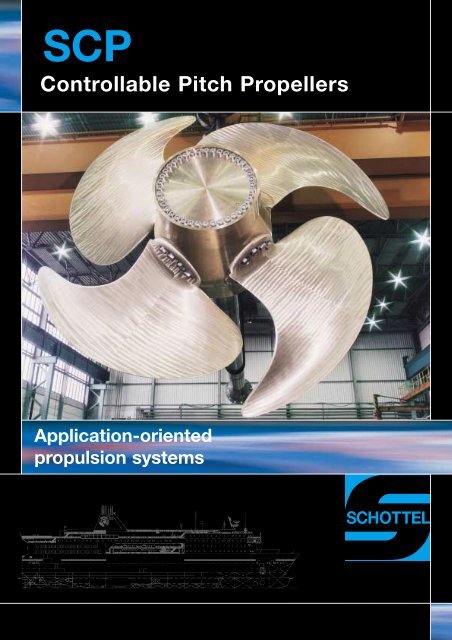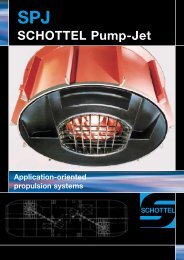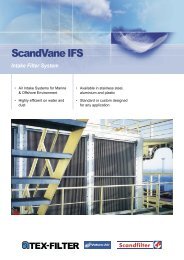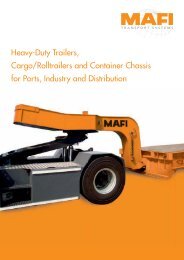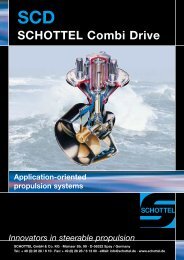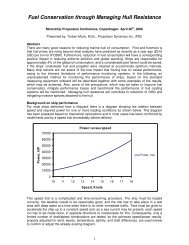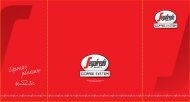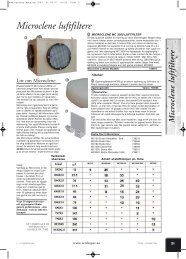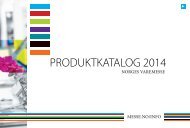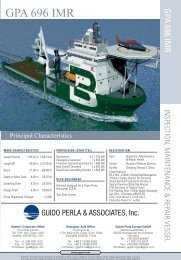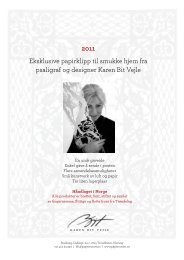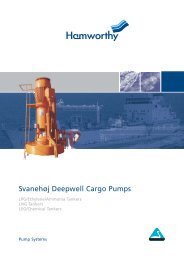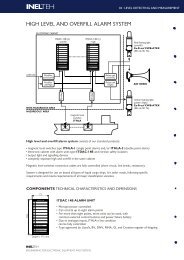Controllable Pitch Propellers
Controllable Pitch Propellers
Controllable Pitch Propellers
Create successful ePaper yourself
Turn your PDF publications into a flip-book with our unique Google optimized e-Paper software.
SCP<br />
<strong>Controllable</strong> <strong>Pitch</strong> <strong>Propellers</strong><br />
Application-oriented<br />
propulsion systems
The SCHOTTEL <strong>Controllable</strong> <strong>Pitch</strong> Propeller –<br />
the reliable propulsion system<br />
for all ships with up to 30,000 kW<br />
SCHOTTEL <strong>Controllable</strong> <strong>Pitch</strong> Propeller Systems (SCP) are<br />
available in various designs, including:<br />
• X-type, i.e. hydraulic cylinder mounted in the propeller hub<br />
• Z-type, i.e. hydraulic cylinder mounted in the propeller shaft<br />
Oil is distributed either via an Oil Distribution (OD) box mounted in<br />
front of the gearbox (G-type), or via the W-type OD box, which is<br />
mounted in the shafting.<br />
Therefore different combinations of hydraulic cylinder arrangement<br />
and position of oil supply can be implemented. The most common<br />
is the X-type hub combined with oil supply in front of the gearbox,<br />
the so-called “XG” configuration. Other solutions are the “ZG”<br />
version, with the hydraulic cylinder in the shaft and the OD box in<br />
front of the gearbox, and the “XW” version, with the cylinder in the<br />
hub and the oil supply in the shaft.<br />
The “X” type incorporates a hydraulic cylinder with the piston<br />
directly connected to the yoke. Hence the design is simple, with a<br />
minimum of moving parts, and achieves the highest reliability.<br />
2<br />
To obtain optimum strength the hub is cast in one piece. The propeller<br />
blades are mounted on large-sized blade carriers to minimize the<br />
stresses in the system.<br />
The yoke moving inside the hub is supported by sliding pieces. Crank<br />
pins on the yoke operate the propeller blade carriers, which have<br />
grooves guiding the pins. The propeller blades are bolted to the<br />
carriers. The hub is sealed by a well-proven system consisting of a<br />
pre-loaded sealing ring between the hub and the blade foot.<br />
The hydraulic oil flows through an inner and outer oil pipe, both<br />
mounted concentrically inside the hollow-bored shaft. The movable<br />
double oil pipe also functions as a feedback system indicating the<br />
current pitch of the propeller system.<br />
The Z-type hub with the hydraulic cylinder within the propeller shaft results<br />
in a considerably shorter propeller hub. The shaft-integrated hydraulic<br />
cylinder moves the yoke by means of a rod leading through the hollow-bored<br />
shaftline.<br />
For all systems, propeller blades and hubs are available made of Cu-Ni-Al or even<br />
stainless steel.<br />
<strong>Controllable</strong> pitch propellers designed by SCHOTTEL offer the following advantages:<br />
• blocking valves for pitch setting installed in the cylinder space of the hub, easily accessible<br />
when docked without dismantling of the hub<br />
• blocking valves allow operation in the ahead condition with 100% engine power without restriction<br />
• blades can be dismounted in a nozzle without pulling the shaft<br />
• the blade moving pin is part of the cast yoke, which achieves a larger control stroke near the end<br />
positions of the blades, allowing finer pitch control. This also results in lower stresses in the pin.<br />
• optimum matching of material between hub and blade carriers<br />
• larger hub is cast in one piece, giving a rigid structure
Company Profile<br />
SCHOTTEL-Schiffsmaschinen GmbH,<br />
formerly Wismarer Propeller und Maschinenbau<br />
GmbH (WPM), can look back on<br />
a long history of industrial activity in<br />
Wismar, Germany. Previous names were<br />
“Alubau Wismar” and “Diesel Motorenwerk<br />
Rostock” (DMR). WPM became<br />
independent in 1991, and was taken over<br />
by SCHOTTEL in 1998. The company<br />
delivered its first controllable pitch propeller<br />
in 1963. Previously, the propellers<br />
were primarily manufactured for the<br />
strong East German shipbuilding industry.<br />
Today, as part of the SCHOTTEL Group,<br />
SCHOTTEL-Schiffsmaschinen GmbH is<br />
well-positioned for aggressive development<br />
of the international market.<br />
Today more than 100 employees use<br />
modern facilities to produce the following:<br />
• SCP controllable pitch propeller<br />
systems<br />
• shafts for fixed pitch propellers<br />
• rudder shafts and machining of rudder<br />
blades<br />
First controllable pitch propeller from<br />
Wismar built in 1963 for a fishing trawler<br />
1,210 kW, diameter 3.3 m<br />
3<br />
The SCP power range starts at 1000 kW<br />
and goes up to 30,000 kW, with corresponding<br />
hub diameters from 0.46 m to 2 m.<br />
The propellers are available with 3, 4 or<br />
5 blades, the standard version being the<br />
four-bladed design. SCHOTTEL supplies<br />
the complete package including the CP<br />
propeller, shaftline, hydraulic system and<br />
remote control system.<br />
In another product line, SCHOTTEL<br />
designs and machines shafts of up to<br />
19.5 m in length and 80 t in weight.<br />
One 12 m, one 15 m and two 20 m<br />
lathe machines are available for manufacturing<br />
these large shafts. With its<br />
machine capacity the company is<br />
excellently equipped for repairs and<br />
machining work.
SCP Types<br />
Principle: *** *** ***<br />
Example: SCP 154 4XG<br />
SCHOTTEL<br />
<strong>Controllable</strong> <strong>Pitch</strong> Propeller<br />
Size of Hub, Diameter in cm<br />
Number of Propeller Blades<br />
Hub/Control Cylinder Arrangement<br />
Hydraulic Oil Supply Arrangement<br />
(G: At Gear, W: Inside Shafting)<br />
Position of Control Cylinder<br />
Hub Material Inside Shafting Inside Hub<br />
Steel<br />
Bronce<br />
A<br />
Z<br />
C<br />
X<br />
Type SCP-XG<br />
X-type hub with the servomotor fitted in the hub, the oil supply unit<br />
arranged in front of the reduction gear.<br />
4<br />
Type SCP-ZG<br />
Z-type hub with the servomotor in the shaft line, the oil supply unit<br />
arranged in front of the reduction gear.<br />
Type SCP-XW<br />
X-type hub with the servomotor fitted in the hub and the oil supply unit arranged in the shafting.
Propeller Design<br />
Designing a CP propeller blade is a complex process,<br />
requiring an extensive range of expert knowledge in the<br />
specialized fields of fluid physics and mechanical engineering.<br />
In addition to hydrodynamic blade design, the calculation<br />
of hydrodynamic loads and their effects when the<br />
blade pitch is changed and in various operating conditions<br />
are of great importance.<br />
In order to provide advanced blade shapes and satisfy<br />
ever-heightened requirements, use is made of state-of-theart<br />
calculation methods, refined continuously by means of<br />
Computed pressure distribution<br />
research projects carried out in cooperation with research<br />
institutes.<br />
The blade design is initially executed through the use of circulation theory verification and optimization<br />
techniques. Here SCHOTTEL employs two tried-and-tested methods developed at the<br />
HSVA in Hamburg and the SVA in Potsdam, which are currently<br />
the most powerful programs in existence. Openwater<br />
diagrams, pressure distribution, cavitation and pressure<br />
fluctuation properties are calculated for all relevant<br />
operating states in the vessel’s wake.<br />
In addition to close cooperation with research institutes,<br />
SCHOTTEL also draws on the invaluable years of experience<br />
of leading experts in the field of propeller design.<br />
The strength of the blade is verified through the use of<br />
FEM (Finite Element Method), achieving the optimum combination<br />
of mechanical expedience and hydrodynamic efficiency.<br />
Cavitation test<br />
Almost every propeller undergoes extensive model tests, where it must prove that it actually<br />
possesses the required characteristics with regard to efficiency, cavitation and pressure fluctuations.<br />
In these tests the SCHOTTEL design regularly competes head-to-head with technology<br />
from other suppliers, and as the results show, SCHOTTEL produces some of the best propeller<br />
designs on the market.<br />
Hydraulic System<br />
The pump and motor unit forms an essential part of the<br />
hydraulic system. This assembly delivers the oil quantity<br />
needed for adjustment of the propeller blades and produces<br />
the pressure required for pitch control. Two electrically<br />
driven pumps (1 active pump, 1 standby pump, each with<br />
100% capacity) are mounted on the cover of the hydraulic<br />
tank, with the pumps running in the oil. The compact control<br />
block, incorporating all the indicators and the individual Hydraulic unit<br />
instruments necessary for pitch control, is located on the<br />
top of the tank. The piping between the pump and motor unit and the oil supply unit is part of<br />
the shipyard’s scope of supply. Lubrication oil is fed through the stern tube into the hub. This<br />
system is not connected to the hydraulic system of the controllable-pitch propeller unit.<br />
Optionally a two-pipe system can be supplied, in which case the hydraulic oil is used to lubricate<br />
the hub.<br />
Remote Control<br />
The remote control system is<br />
designed to provide automatic<br />
control of a SCHOTTEL controllable<br />
pitch propeller. The<br />
system is based on a microprocessor-controlled<br />
system<br />
architecture with 2-wire bus<br />
communication between central<br />
unit, ECR and bridge. An HMI<br />
(human-machine interface) allows<br />
clear, user-friendly control, set-up<br />
and maintenance of the system.<br />
The system is type-tested to GL,<br />
LRS and ABS (other classes on<br />
request) and meets class requirements<br />
according to AUT24 and<br />
UMS.<br />
Standard features:<br />
• Control from ECR, bridge and<br />
wings<br />
• Combinator and constant<br />
speed mode<br />
• Up to 3 acceleration programs<br />
• Load control management<br />
• Automatic SLOW DOWN<br />
• Automatic SHUT DOWN<br />
• Self monitoring<br />
• Non-follow-up control from<br />
ECR and bridge<br />
• <strong>Pitch</strong> measurement system<br />
• Main engine interface<br />
The system is powered with 24 V<br />
DC. A separate supply should be<br />
provided for the back-up system.<br />
Options:<br />
• Engine telegraph systems and<br />
electric shaft system in the<br />
wheelhouse area<br />
• Clutch control system<br />
• Interface for DP systems<br />
• Interface for manoeuvring<br />
printer<br />
5
SCP in action<br />
4<br />
6<br />
1<br />
1 COT WOLGASTERN<br />
SCP 1414 XG (7860 kW)<br />
Shipyard: Gdynia Shipyard, Poland<br />
Owner: Rigel Schiffahrt, Germany<br />
2 Open Top Container Vessel, Type 168 A<br />
1 x SCP 1294 XG (8400 kW)<br />
Shipyard: Sietas-Werft, Germany<br />
3 RoPax ferry NORRÖNA<br />
2 x SCP 1294 XG (10,800 kW each)<br />
Shipyard: Flender Werft AG, Germany<br />
Owner: Smyril Line, Faroe Islands<br />
4 Offshore Supply Vessel C. LIBERTY<br />
2 x SCP 0774 ZG (2110 kW each)<br />
2 x STT 1010 T-LK CP (1000 kW)<br />
Shipyard: North American Fabricators, USA<br />
Owner: Edison Chouest Offshore, USA<br />
2<br />
3<br />
5 EGV BERLIN<br />
2 x SCP 1414 XG (5280 kW each)<br />
Shipyard: Flensburger<br />
Schiffbaugesellschaft, Germany<br />
Owner: German Navy<br />
5
7<br />
8<br />
6<br />
6 Passenger/Container vessel ZI YU LAN<br />
1 x SCP 1544 XG (15,000 kW)<br />
Shipyard: Aker-MTW, Germany<br />
Owner: Shanghai Shipping Corporation,<br />
PR China<br />
7 AHSV HADI XI<br />
2 x SCP 0714 XG (2025 kW each)<br />
Shipyard: Keppel Singmarine, Singapore<br />
Owner: Hadi H. Al-Hammam Establishment<br />
– Marine Services, Saudi Arabia<br />
7<br />
8 Atlantik 488, 1 x SCP 119 4 AW (5300 kW)<br />
Shipyard: Volkswerft GmbH Stralsund,<br />
Germany<br />
Owner: Murmansk Trawler Fleet Co.,<br />
Russia<br />
9<br />
9 RoRo vessel AKDENÍZ<br />
2 x SCP 1294 XG (8100 kW each)<br />
Shipyard: Flensburger Schiffbau-<br />
Gesellschaft, Germany<br />
Owner: UND Roro Isletmeri AS, Turkey<br />
9
SCHOTTEL for the Shipping World<br />
■<br />
■<br />
■<br />
■<br />
Constant customer support<br />
Professional commissioning world-wide<br />
Preventive maintenance and repairs<br />
Close-knit sales and service network<br />
Our product information provides you with explanations and data for planning plants incorporating units from our current programme.<br />
On account of the modifications associated with upgrading, the contents of a specific edition will remain valid for a limited time only.<br />
Binding for the application concerned are the data given in our tender specification.<br />
VPR-525/05 e . Printed in the Federal Republic of Germany<br />
Innovators in steerable propulsion<br />
SCHOTTEL-Schiffsmaschinen GmbH · Kanalstr. 18 · D-23970 Wismar / Germany<br />
Tel.: + 49 (0) 38 41 / 204-0 · Fax: + 49 (0) 38 41 / 204-333 · eMail: info-ssw@schottel.de · www.schottel.de


